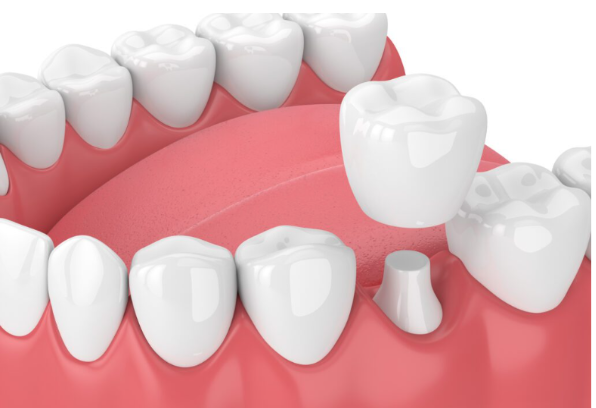Have you just damaged or fractured a tooth? Do you need support for worn or weakened teeth? A dental crown can help. A crown is a dental restoration that fully covers and protects damaged teeth and dental implant posts. Dr. Walter Mazzella provides custom-made dental crowns to restore patients’ smiles. He helps patients receive comfortable dental crown treatment in Woodstock, MD. Dr. In addition, Dr. Mazzella provides additional restorative dentistry services to patients in Woodstock, MD, and the surrounding areas.

What Are the Benefits of Dental Crowns?
We offer cubic zirconia dental crowns, which offer durable yet natural-looking results. Once patients complete dental crown treatment, they will find they look and function like natural teeth. Zirconia crowns are made of metal with durability similar to titanium. These types of crowns can also blend in with the look of other permanent teeth. We can color-match crowns for a seamless look.
Tooth crowns not only treat natural teeth but can also cap off dental implants and other restorations. Additionally, we can work with you to create customized crowns to top a dental implant or hold a dental bridge.
Dental Crown Treatment in Woodstock, MD
It can take two to three appointments to receive dental crowns. The first appointment typically involves cleaning, filling (if necessary), and shaping the tooth precisely for the new crown to fit over it comfortably. If patients do not have enough tooth structure for a crown, we will recommend a crown-lengthening treatment. This treatment contours the gums to expose more of the bone.
We then take a putty or a digital “impression” made with a 3d intra-oral wand scanner, which takes an intricately precise rendition of your teeth and bite, which we send to our expert lab technicians. We custom-make a temporary acrylic crown or bridge for you to wear for a few weeks while the area heals and your permanent crown or bridge is fabricated. In your shorter follow-up appointment, Dr. Mazzella will ensure that the final fit, feel, and aesthetic is perfect, making any micro-adjustments as necessary before permanently cementing the final restoration.
What Are Inlays and Onlays?
Also known as partial crowns, inlays and onlays cover smaller areas of single teeth. Like dental crowns, inlays and onlays are separate tooth-colored restorations that we attach to teeth. Inlays cover the chewing surface of the tooth between the tooth cusps. Onlays cover this chewing surface and the cusps.
Patients with tooth damage benefit from inlays and onlays if their dental injuries are near the surface or top of their teeth. Like dental crowns, inlays and onlays can easily blend in with the color of natural teeth.
Dental Crown FAQs
Are zirconia crowns a better option than porcelain or metal ones?
Zirconia crowns are often chosen for their strength, durability, and natural appearance. They’re stronger than traditional porcelain and don’t have the dark metal line often seen near the gums with porcelain-fused-to-metal crowns. However, porcelain crowns typically offer superior aesthetics for front teeth due to their translucency. Dr. Mazzella will recommend the best type based on your tooth’s location, function, and aesthetic goals.
Will a dental crown feel different from my natural teeth when chewing?
Initially, a new crown might feel slightly different or higher than your natural teeth. Your dentist adjusts it to ensure a proper bite, and after a few days, it usually blends seamlessly into your bite pattern. Crowns are designed to mimic the feel and function of your original tooth closely. After the initial adjustment period, most patients don’t notice any difference when chewing.
How do I know if I need a crown instead of an inlay or onlay?
A crown is typically needed when your tooth has significant decay, cracks, or structural damage that weakens it extensively. Inlays or onlays work well for smaller areas of decay or damage where more of the original tooth structure remains intact. If the tooth’s damage extends to multiple surfaces or significantly weakens the tooth, a crown is a better option. We will assess the tooth’s strength and decay size to recommend the best treatment.
Can I receive a crown if I have gum disease?
You’ll need to manage your gum disease first before getting a crown. Healthy gums provide a stable foundation for restorations. Untreated gum disease could compromise the crown’s longevity. Dr. Mazzella will recommend scaling and root planing or other treatments to control infection before crown placement. Once your gums are healthy, a crown can be successfully placed.
Is anesthesia used during the crown preparation process?
Yes, local anesthesia is typically used to numb the tooth and surrounding area during crown preparation. This ensures you remain comfortable while the dentist shapes the tooth and removes decay. Most patients find the procedure painless with anesthesia, though you may feel slight pressure. Dr. Mazzella will discuss sedation options if you’re anxious or sensitive.
Can children or teens ever need dental crowns?
Yes, children and teens sometimes require dental crowns, especially after significant decay or trauma to baby or permanent teeth. Pediatric crowns, often stainless steel or tooth-colored, can protect damaged baby teeth until permanent teeth come in. Teens might receive porcelain or zirconia crowns on permanent teeth damaged by decay or injury. Crowns help preserve function, maintain spacing for developing teeth, and prevent future dental issues.
Restore Your Teeth
Are large areas of tooth wear impacting the comfort of your bite? Treat tooth damage today. Schedule a dental appointment with Dr. Walter Mazzella online. You may also call (410) 559-9951 to request a dental crown consultation.
